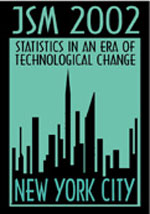|
Activity Number:
|
363
|
|
Type:
|
Contributed
|
|
Date/Time:
|
Wednesday, August 14, 2002 : 2:00 PM to 3:50 PM
|
|
Sponsor:
|
Biometrics Section*
|
| Abstract - #301353 |
|
Title:
|
Latent Variable Mixture Modeling: Analyzing Mixture and the Structural Portion of Model
|
|
Author(s):
|
Hayrettin Okut*+ and Terry Duncan and Susan Duncan and Lisa Strycker
|
|
Affiliation(s):
|
University of Yuzuncu Yil, Van-Turkey and Oregon Research Institute and Oregon Research Institute and Oregon Research Institute
|
|
Address:
|
1715 Franklin Blvd, Eugene, Oregon, 97403, USA
|
|
Keywords:
|
Latent class ; Mixture modeling ; Multinomial Distribution
|
|
Abstract:
|
Conventional methods designed for longitudinal data assume that the data come from a single population that has varying trajectories. These methods assume that covariates have the same influence on the growth factors. However, individuals with different change trajectories may not only have different growth shapes. Growth mixture modeling enables the researcher to study different changing processes across individuals belonging to several groups. Latent variable growth mixture modeling includes models with a combination of categorical and continuous latent variables. A categorical latent variable is used to represent a mixture of groups in which membership is not known but inferred from the data. This is referred to as finite mixture modeling. Latent variable mixture modeling consists of a mixture portion of the model and the structural portion of the model. In the mixture portion of the model, the categorical latent variable is allowed to influence binary and/or ordered categorical observed outcomes referred to as latent class indicators, and to be regressed on observed variables/covariates. Structural portion of the model, all parameters are allowed to vary across the latent classes.
|

